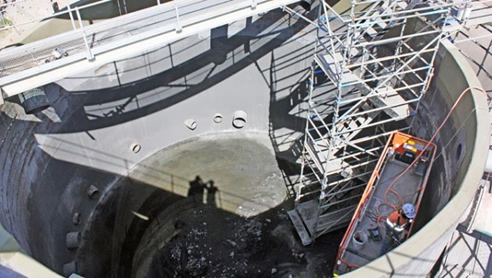Watertight Argument from Projex Group The company was founded in 1988 by Jim Kornmehl when he saw an opportunity to introduce the German-made Wolfin waterproofing system to the Australian market. Since then, Jim and his team have added several other world-leading brands - all designed to supply the absolute best materials to solve the problem. Today, Wolfin is one of three core products Projex carries, Jim says. It was the first and it "came about as an accident." He owned a large building in North Sydney with excess parking space, was looking to rent it out and attracted the interest of a company in the computer business, who not unnaturally wanted it to be guaranteed waterproof. "No problem, we said. But then they said 'when we mean guaranteed, we MEAN guaranteed'. We could not find anything locally; then we looked around the world and found Wolfin." Wolfin makes thermoplastic membranes, primarily for waterproofing flat roofs and buildings. The material can be used for waterproofing any type of roof as well as repair of roofs of almost any material, usually without removing the failed membrane. It is used for waterproofing of balconies, terraces, decks, basements and in planter boxes (it is certified root-proof); in gutters - or as a pre-made gutter; bunding; under carpark surfaces and on the joints; under concrete slabs to prevent seepage - even under high pressure; on expansion joints, tunnel walls and bunkers; in water tanks, fountains and water features, dams and sewage tanks; and on railway or road bridges. This was high-end technology and solving a problem to a degree of prevention of ingress that not everyone needs, so it took a while before Wolfin became popular in Australia. Jim says they are not interested in run-of-the-mill waterproofing, only where it's really vital to keep all liquid at bay. "We won't do a local garage or a semi-detached in the country. But when it is important that it is completely waterproof, then people will use Wolfin." While this product grew in popularity, people were also asking Jim and his colleagues Michael 'Harry' Herder and Nick Pearson for solutions to similar problems, such as needing a waterproof course that would stand walking or other heavier use but without recourse to tiles which would be too heavy. Accordingly, Projex sourced another German product called Shockmat, made of reclaimed rubber, sourced from the tyre industry, bonded together with polyurethanes. This product has many commercial and industrial applications and is ideal as a protective matting medium. It is also widely used for waterproofing membranes, as a sound reducing medium or on railway bridges for ballast protection. As a membrane protective medium, Shockmat is cheaper and easier to install than tiles or concrete screeds and is installed by simply rolling out. This attracted the attention of railway engineers throughout Australia. They wanted to know if Shockmat, now being used on many bridges, could additionally be used as a ballast mat. "I thought it was interesting so we checked with the company in Germany - and they had just started manufacturing ballast mats." They are made the same way - recycled car tyres bonded to fine tolerances and tuned. "You would have a different type of matting for a train that travels over it at 100km/h than for a train travelling at 50km/h." The type also varies with axle load. Next, because of Projex' connection with waterproofing, came questions from industry and customers about sealing pipes that go through walls. This time the trail led to the US and a brand called Link-Seal. Link-Seal provides a range of engineered products designed to be used together, for quickly and easily creating a permanent seal between a cylindrical object and the barrier through which it passes. "This fitted in well. We had different things to offer to essentially the same customers, and the business has really been built on these three ranges." For a couple of years, Projex also marketed a system for passive fire protection, but Jim says it was never a comfortable fit with his company which is a rather laid-back outfit. "We work hard but we have a lot of laughs. People in the fire industry tend to be a bit serious." Jim and his team prefer to concentrate on marketing the waterproofing and allied systems to customers who generally appreciate the total proofing and are willing to pay for the quality. In some applications (most mines, for example) absolute prevention of water ingress is not a priority. Jim says the difference between 98 per cent protection and 100 per cent "is probably a factor of three." But if you need 100 per cent for a specific application (a power station, say, or electrical sub-station), then cost is unlikely to be the main driver, although as Jim says "it sometimes takes two or three goes to prove that." It is not unknown for a project owner to specify the top system but for a builder to talk him out of it in favour of something cheaper. "Then two or three years later the owner will call us and complain 'your system is leaking' and we say we didn't install it." Eventually, Projex gets called in to do the job properly. "This is a very common occurrence." It is a very false economy, he points out. "If you look at a hospital, for example, it means shutting down operating theatres if even a little water gets in. That means re-sterilising everything. It's a big deal." Spending extra to ensure that total water-tightness makes sense if you have equipment inside a building that must be shielded, and Projex spends most of its time talking directly to engineers and owners rather than builders. Jim says one of the company's strengths is keeping large amounts of materials in stock. Because the whole industry is not as good at ordering in advance as it is at building things, everything is urgent. "It's very expensive to keep stock, but it's part of the service and we are in a service industry." Despite that laid-back appearance, Projex takes its customers very seriously indeed and aims to supply "around 98 percent of all orders from stock." It doesn't stop there, either, because the team is aware that even the best products and systems must be installed correctly. Companies across Australia that install Wolfin have to sign up to promise to do things in our approved manner. "We inspect every installation without fail. We are a pain in the rear! And if we find something wrong, they have to - at their cost - take it out and do it properly. Because we warrant it as waterproof." Even for a few square metres in Hobart, "we fly down there to do it." And this policy evidently pays off; despite his protestations of poverty, Jim and Projex are flourishing. Not, you might say, just keeping their heads above water.
|
02 8336 1666 Westfield Commercial Office Tower Suite 506, Level 5 152 Bunnerong Road, Eastgardens NSW 2036
|



 Steel Sleeves for Bund Walls by Projex
Steel Sleeves for Bund Walls by Projex Mechanical Sealing Solutions for Pipe
Mechanical Sealing Solutions for Pipe Protection Mat for Infrastructure
Protection Mat for Infrastructure Pipe Penetration Sleeves for Concrete
Pipe Penetration Sleeves for Concrete Polyester and PVC Waterproofing Membrane
Polyester and PVC Waterproofing Membrane Sound Deadening Mat by Projex Group
Sound Deadening Mat by Projex Group Benefits of Cosmofin Waterproofing for
Benefits of Cosmofin Waterproofing for How to Create Round Pipe Penetrations
How to Create Round Pipe Penetrations Advantages of Damtec Sub Ballast Mat by
Advantages of Damtec Sub Ballast Mat by Waterproofing Membrane for Fountains by
Waterproofing Membrane for Fountains by Century-Line Pipe Penetration Sleeves by
Century-Line Pipe Penetration Sleeves by Cosmofin PVC Waterproofing Membrane by
Cosmofin PVC Waterproofing Membrane by Why Balconies Leak by Projex Group
Why Balconies Leak by Projex Group Shockmat Protection Matting by Projex
Shockmat Protection Matting by Projex Advantages of the Link Seal System by
Advantages of the Link Seal System by UV Stable Waterproofing Membrane by
UV Stable Waterproofing Membrane by Steel Sleeves for Bund Walls by Projex
Steel Sleeves for Bund Walls by Projex Sub-Ballast Mats for Railway Projects by
Sub-Ballast Mats for Railway Projects by Environmentally Friendly Waterproofing
Environmentally Friendly Waterproofing Wolfin Membrane Planter Box
Wolfin Membrane Planter Box
